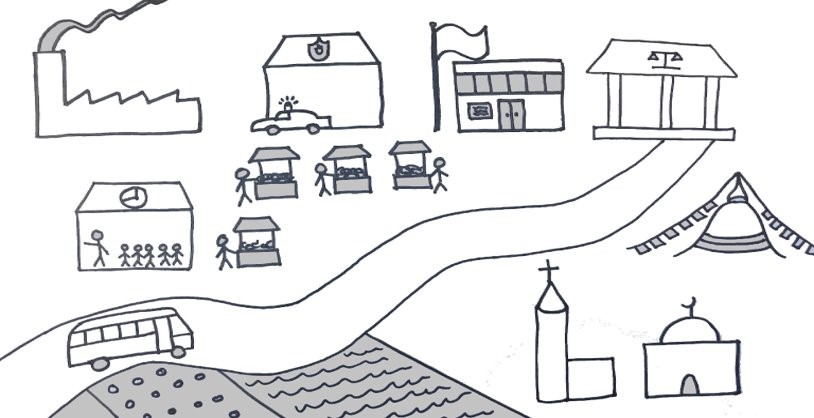THINK (5 MIN)
Ask everyone to silently pick a character who they think would face problems related to freedom of thought, conscience, religion or belief in their country/community.
Ask them to look at the ‘map’ and spend 3 minutes thinking about the following question: In which places on the map would your character face problems because of their ideas or religious identity, practices or beliefs? What problems would they face?
Make sure it is clear that the task is to map the experiences of victims of violations rather than focusing on perpetrators.
SHARE AND DOCUMENT (45 MIN)
1. Ask one person to say which character they chose and, very briefly, what places on the map their character could face problems and what kind of problems these are.
2. On the flipchart sheets, briefly note the character and the type of problems they mention next to each place a problem is experienced. For example, you might write ‘Inter-religious couple – harassment’ next to the bus.
3. Stop the person who is sharing after 2 minutes, even if they have only said a few of the places/problems they thought of. This is to ensure others have time to contribute!
Ask if anyone else chose this character and if they have additional points to make about this character. Encourage some discussion and storytelling at this point.
Ask if any of the other characters would face the same problems in the same places. Note these characters next to the problems concerned.
Repeat steps 1-3 above asking another person about a character they chose. Continue going through the characters until there are 10 minutes left of the 45 minutes allocated. At this point, ask everyone who has a problem that has not been discussed yet to come up and write the problem at the relevant place on the map, noting the character concerned. Spend the last few minutes reading each other’s additions.
TIP! As this exercise is quite long, why not take a break here or run an energiser? See ice breaker and energiser exercises for ideas.
KNOWLEDGE INPUT (10 MIN)
Give a short knowledge input based on Candelin’s three phases of persecution model: disinformation – discrimination – violence. (See ‘Advance preparation’ above for details of resources to help you do this).
PLENARY DISCUSSION (30 MIN)
Ask everyone to sit in a semi-circle in front of the flipchart map.
Tell the group that they are going to analyse the findings of their mapping using the model they learnt about in the talk.
Ask the following questions and write up key points from the discussion on blank flipchart sheets. If additional problems or characters come up in the discussion, make a note of these on the map too.
- Are there examples of disinformation, discrimination and violence on our map?
- Who is affected by the problems we identified?
– Who is particularly vulnerable in our community?
– Do women and girls face different problems and vulnerabilities than men and boys?
- How serious are the problems in terms of frequency, scale and impact?
– Frequency: Do the problems we have identified occur occasionally or frequently? Are any of them systematic – built into the way society works?
– Scale: Are a few or many people are affected by the problems? Which problems affect most people?
– Impact: Which problems have the most severe impact on those affected? Remind the group that even if only a few people are affected, if a violation has a devastating impact on those people, it is a really serious problem.
- Who is contributing to the problems?
– Is the state actively committing violations, passive about the problems created by others, or active in promoting FORB?
– Are WE ever part of the problem, consciously or unconsciously?
- Are there characters – individuals or religious communities – whose problems we don’t really know or understand properly? Could we find out about their experiences and add this to our map and our analysis?
- (Optional) What feelings are coming up as we work to identify and analyse these problems?
During the discussion, try to highlight how examples raised by participants illustrate how FORB violations often involve violations of other rights too, for example, women’s rights, rights to education or employment. Make the point that our human rights are all interconnected. We need them all!
